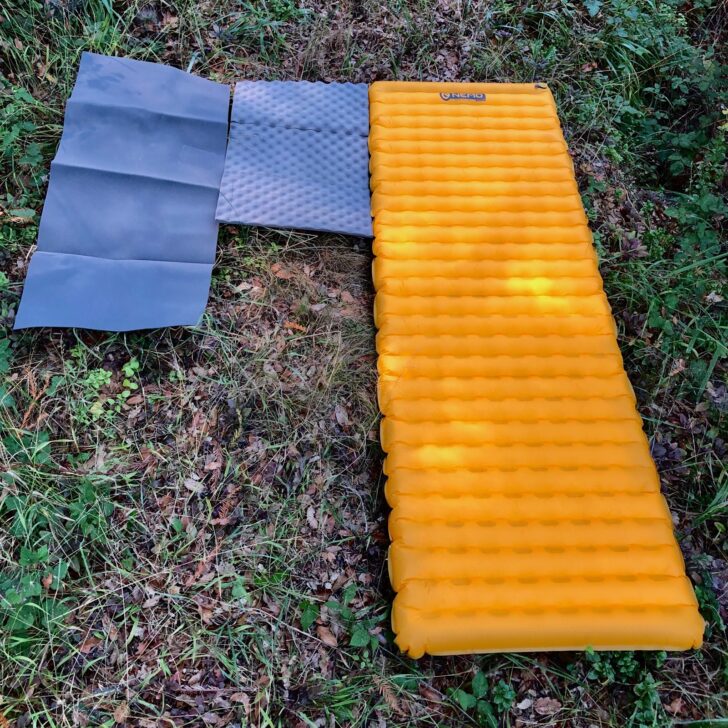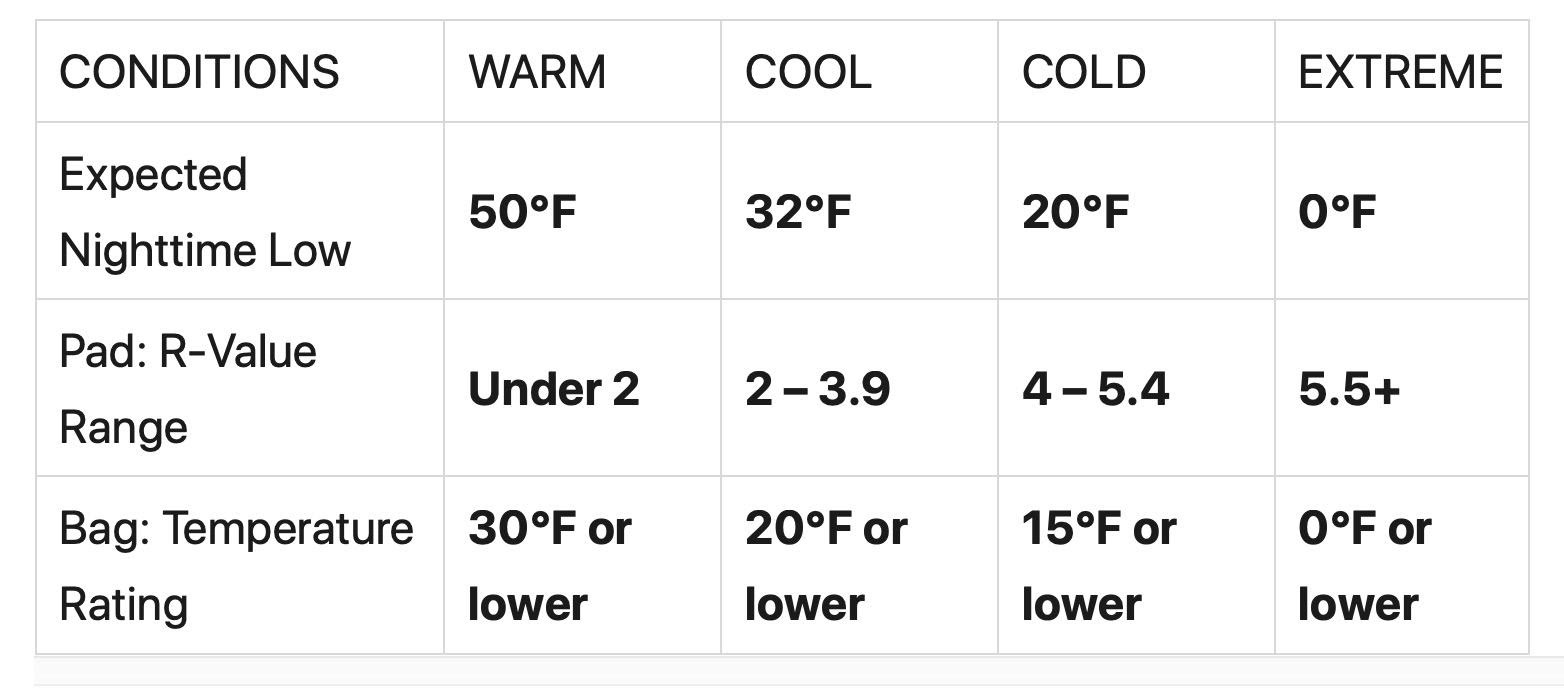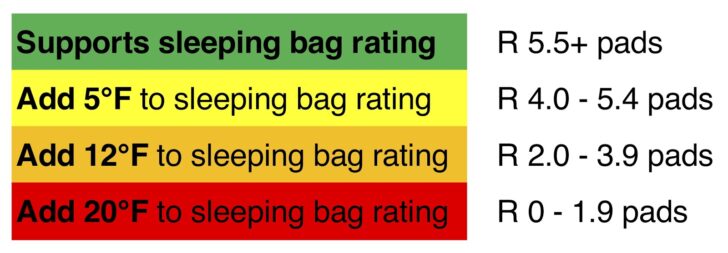Introduction
Sleeping pad R-values are not that useful for many consumers, and the guidance from pad makers, retailers, and gear reviewers is inconsistent and prone to misinterpretation. This is a proposal for improved labeling and marketing that requires further development.

REI published a chart this year comparing expected low temperatures, R-values, and sleeping bag temperature ratings.

One curious thing about this table: the ISO 23537 standard for measuring sleeping bag temperature ratings specifies an R 4.8 sleeping pad. However, that R-value doesn’t seem sufficient in REI’s testing.
Initial Idea
Using the above chart, and making lots of assumptions, I created a first draft alternative labeling and recommendation system for sleeping pads:

Retailers and reviewers could group sleeping pads this way to help consumers make better choices. For example, all the pads in the “Add 20°F” (11 C) category can be grouped into one area or a store or online review.
Further Development
One-time independent testing, perhaps through a standards body like ASTM or ISO, could improve this system. The tester would gather a selection of sleeping bags at different ISO 23537 temperature ratings plus sleeping pads at several ASTM F3340 standard R-values. Afterward, they would use ISO 23537 tests to measure sleeping bag temperature ratings using different sleeping pads.
For example, if a 20 F (-6 C) comfort rated sleeping bag tested on an R 3 pad returns a 35 F (+2 C) comfort rating, then the 15 F (8 C) difference applies to that R-value. In other words, “Add 15°F” (8 C). In the end, testers would calculate an average “Add” number for each pad, and perhaps derive a more general formula connecting R-values to temperature differences. They could also test the REI chart’s curious part, which might be due to temperature-dependent R-values.
Revised Chart
To communicate more clearly with consumers, I grouped R-values into “Supports,” “Add 5° F,” “Add 10° F,” and “Add 20° F” chunks. For the metric world, perhaps group into “Supports,” “Add 2.5 C,” “Add 5 C,” and “Add 10 C” chunks. I chose the word “Add” rather than a plus sign to reduce confusion. I also assigned new colors to make it easy for consumers to distinguish between different pads, group similar pads together, and better understand the consequences of choosing a pad with a lower R-value.


Consumers who want a warmer or colder pad than the one they are looking at can use these charts to find products in the right range. People with more backcountry experience might still choose a pad in a higher “Add” category (i.e. lower R-value) for use during warmer weather in order to save money, or weight, or to gain comfort. Many seasoned backpackers layer two pads: an air pad for comfort plus a foam pad to add sufficient insulation, since R-values are roughly additive. But I hope new backpackers would choose an R 4.8 or higher pad if they can afford one, and sleep warmer.
I am not a color or design expert. In the draft proposal, consumers might interpret the red color as warning or warmer, causing more confusion. By changing the colors and including the “Add” numbers, R-value ranges, and product R-value with an arrow, I hoped to reduce that uncertainty.
Industry Support
Why should the backpacking industry support a scheme that obviously makes some pads less desirable? According to an Enlightened Equipment video, 50 percent of their customer complaints about cold sleeping bags, and quilts were traced to using a sleeping pad that’s not warm enough.
Many pad makers also produce sleeping bags, including Alps Mountaineering, Big Agnes, Exped, Nemo, REI, Sea-to-Summit, Sierra Designs, and Therm-a-Rest. It would be in their self-interest to use a system like this to improve customer ratings and reduce complaints and returns. Also, warmer pads usually sell at higher prices than colder pads. Gear makers would still measure and publish sleeping pad R-values, but manufacturers and retailers could communicate more effectively with their customers by using this scheme.
Conclusion
I’m not holding my breath. Running a bunch of ISO 23537 tests at $600 each plus analysis and standards development would be a costly one-time investment that no single manufacturer or retailer could justify. And the switch to ASTM F3340 standardized R-values this year was too recent, too confusing, and too expensive. But we can hope – and suggest that the industry improves.
Please post your suggestions below to enhance this proposal.
More Information
- “How Do You Know Which Sleeping Pad Will Keep You Warmer?” REI https://www.rei.com/blog/camp/just-how-warm-is-that-sleeping-pad
A short explanation of R-values and pads as part of a sleep system, with the chart that inspired this story.
- “It’s the Pad | Tim Talks” Enlightened Equipment
In this 2:39 video Tim Marshall explains that half of his unhappy sleeping bag and quilt customers used a sleeping pad that’s not warm enough.
- “Sleeping Bag Systems for Adults: Thermal Insulation and Temperature Ratings” Kansas State University
https://www.k-state.edu/ier/testing/2017%20Sleeping%20Bag%20Insulation%20and%20Temp%20Ratings.html
Kansas State is the best-known U.S. independent tester of sleeping bag temperature ratings.
Related Content
More By Rex Sanders
- Check out the first installment of Rex’s new monthly column: Standards Watch: Introduction!
Reviews
- Our most recent sleeping pad review is for the Nemo Tensor Insulated Sleeping Pad. Probably the BPL staff’s favorite sleeping pad.
Forum
DISCLOSURE (Updated April 9, 2024)
- Backpacking Light does not accept compensation or donated/discounted products in exchange for product mentions or placements in editorial coverage. Some (but not all) of the links in this review may be affiliate links. If you click on one of these links and visit one of our affiliate partners (usually a retailer site), and subsequently place an order with that retailer, we receive a commission on your entire order, which varies between 3% and 15% of the purchase price. Affiliate commissions represent less than 15% of Backpacking Light's gross revenue. More than 70% of our revenue comes from Membership Fees. So if you'd really like to support our work, don't buy gear you don't need - support our consumer advocacy work and become a Member instead. Learn more about affiliate commissions, influencer marketing, and our consumer advocacy work by reading our article Stop wasting money on gear.




Home › Forums › Improving R-Values for Consumers